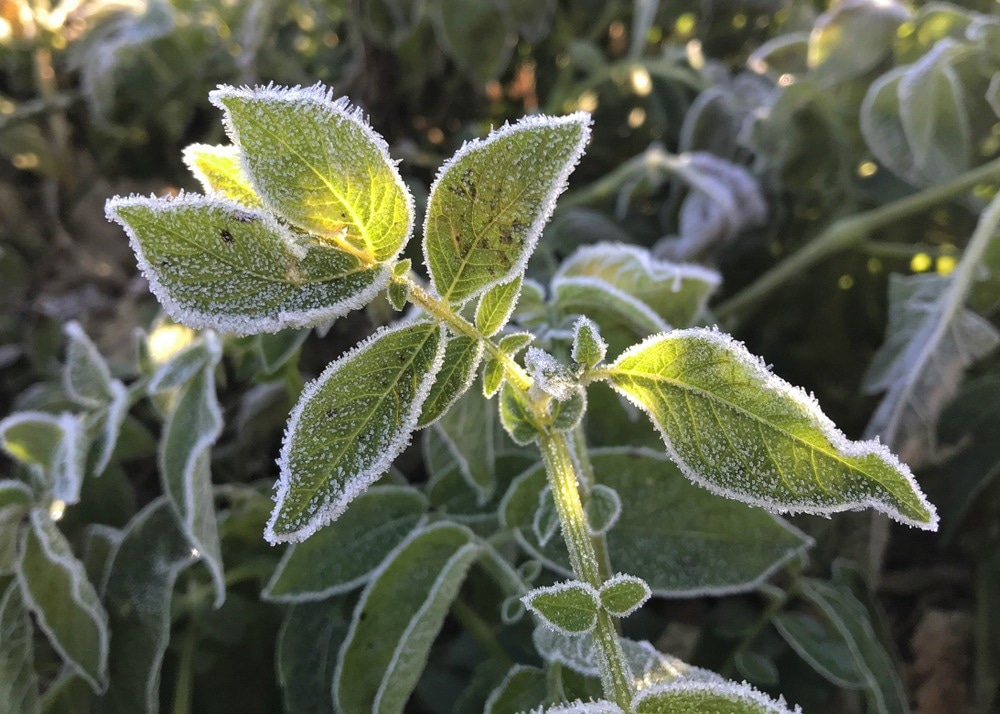A research group from the University of Innsbruck’s Department of Botany, led by Professor Gilbert Neuner, has studied how frost on potato leaves has detrimental effects on potato production. The experiments were conducted using cryo-microscopic techniques. The results are presented in the latest issue of Crops.

Study: Responses to Ice Formation and Reasons of Frost Injury in Potato Leaves. Image Credit: Chad Hutchinson/Shutterstock.com
More than 100 countries grow potatoes, the fourth most significant food crop worldwide. Potatoes thrive best in environments with daily average temperatures between 18 and 20 °C and a minimum of three months without frost. But due to climate change, the likelihood of disastrous spring frosts is rising and will particularly harm potato productivity in colder places.
Effects of Cold Temperature on Potato Growth
In solanum tuberosum leaves, under natural conditions, ice nucleates between -0.5 and -3 °C, and leaves become frost-damaged at -3 °C.
Infrared differential thermal analysis (IDTA) demonstrated that potato leaf freezing occurs in two stages. Ice captured the entire leaf blade during the initial non-destructive freezing event (E1) as it extended extracellularly throughout the xylem. Potato leaves suffered frost damage after a second freezing event (E2) 10–78 minutes later.
Frost causes deadly damage to solanum tuberosum leaves during the second freezing step.
According to one theory, this is brought on by intracellular freezing. Ice crystals grow inside the cell due to intracellular freezing, killing the protoplasts.
However, the process of intracellular ice generation is not well understood. Because the measurement technology used in this early research was insufficient and lacked control over freezing and thawing rates, cellular responses were examined at artificially high freezing rates.
With the help of CO2 gas exchange measurements, Prof. Neuner’s team examined the physiological performance following E1 and E2. Using cryo-light microscopy, the cellular and structural responses during E2 were investigated. The hypothesis the research team wanted to prove was
- Potato leaves' mesophyll cells exhibit freeze-dehydration after E
- Gas exchange activity stops after E1, yet it is not harmful, as ice formation in the gaps between mesophyll cells prevents gas diffusion
- Lethality results from the mesophyll cells' intracellular freezing during E2, which ruptures their membranes and causes irreversible cell damage
Cryo-microscopy
Cryogenic electron microscopy (cryo-EM) was developed to acquire high-resolution images of highly reactive samples. This is challenging with traditional microscopy methods.
Cryo-EM, honored for its contributions with the 2017 Nobel Prize in Chemistry, allows for detailed, high-resolution investigation of soft samples protected from reactive environmental elements. Cryo-light microscopy is a crucial technique for determining target sites and assessing the sample quality in general for cryo-EM.
Using cooling mechanisms such as liquid nitrogen or ethane, the sample under inquiry is frozen to cryogenic temperatures in cryo-microscopy. Samples are kept in their natural state with a thin covering of ice shielding them from the environment since the cooling procedure is carried out quickly. An image is created by firing electrons at the sample or recording frequency shifts using a camera.
The molecules in the sample are arranged in various directions. Using computer software, all the molecules with the same orientation are grouped and the images are sorted. For each sample, thousands of pictures are collected. Additional software editing is implemented to create a high-quality 3D structure of the sample.
Experimental Details
In the current research, solanum tuberosum L. (potato) leaves were examined. Plants were raised in the botanical gardens of the Universities of Salzburg and Innsbruck.
Microscopic slices of mature leaves cut at off-axis angles of 0°, 45°, and 90° were used to measure the anatomy of the leaves.
All laboratory freezing procedures were carried out in either industrial or research chest freezers. Leaves from different individual plants were utilized to measure gas exchange.
On semi-thin sections of high-pressure frozen and freeze-substituted leaf samples, the impact of short-term, non-destructive freezing (E1) on the morphology of the mesophyll cells was examined. Using a cryo-microscope, leaf cross-sections were observed and photographed to evaluate cellular reactions during leaf freezing.
Results and Outlook
After high-pressure freeze-fixation and freeze-substitution, cryo-microscopic techniques were used to evaluate the cytological reactions of mesophyll cells during the creation of ice.
Functional responses and frost damage were revealed by CO2 gas exchange on frozen leaves. After the first freezing, gas exchange continued unhindered. As a result, ice is absent from intercellular spaces and may only be present in xylem vessels.
The mesophyll cells retained their original shape; they did not freeze-dehydrate but rather were supercooled. Initially photo-inhibited following the initial freezing event, leaves resumed photosynthesis after being thawed.
Cells froze intracellularly during the second freezing event, while some palisade parenchyma cells remained viable for a considerable time.
Chloroplasts were destroyed by intracellular ice, and at the light microscopic level, they vanished. After the second freezing, the leaves could not resume photosynthesis. Therefore, the only practical method for potatoes to withstand frost is to avoid freezing.
References
Stegner, Matthias, Othmar Buchner, Tanja Schäfernolte, Andreas Holzinger, and Gilbert Neuner. (2022) Responses to Ice Formation and Reasons of Frost Injury in Potato Leaves. Crops 2, no. 4: 378-389. https://www.mdpi.com/2673-7655/2/4/26
Disclaimer: The views expressed here are those of the author expressed in their private capacity and do not necessarily represent the views of AZoM.com Limited T/A AZoNetwork the owner and operator of this website. This disclaimer forms part of the Terms and conditions of use of this website.